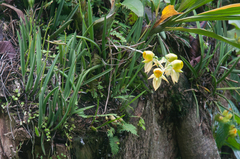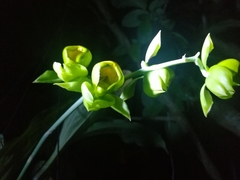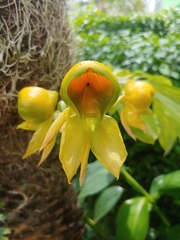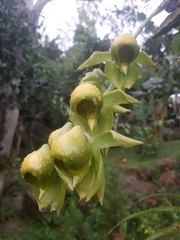

|
|
|
|
Family: Orchidaceae
|
Monoecious or dioecious epiphyte; pseudobulbs large, fusiform, to 25 cm long, enveloped by leaf bases, the older leafless ones persisting. Leaves 6-12-plicate, elliptic-lanceolate, acuminate, 20-48 cm long, 3.5-12 cm wide. Flowers unisexual, dimorphic, on separate, stout racemes from base of pseudobulb; staminate inflorescences erect or arching, 25-70 cm long; staminate flowers 2-12, lacking aroma, to 5 cm long, pale green, aging yellow, the sepals oblong to oblanceolate, acuminate to cuspidate, to 5 cm long, the petals ovate, acuminate, to 4.5 cm long, the lip very firm, subglobose, to 3.5 cm long, green but inside of distal margin yellow (the color fading through to outer surface), the lateral margin ciliate, weakly spurred at base, the column beaked and exserted from lip, the lower edge with 2 antennae, one curved laterally, the other extending out into the spur depression, the anther beaked, ca 1.5 cm long, the pollinia ovoid, ca 6 mm long, ejected from column with considerable force; pistillate racemes infrequent, stouter than staminate racemes; pistillate flowers 2-4, similar to staminate flowers but the sepals and petals fleshy and smaller (to 2.5 cm long), the lip rounded at base, 3-4 cm long, persisting in fruit. Fruits fusiform, heavy and fleshy, to 9 cm long, bluish-green, with 5 broad ribs. Croat 5515, 5546, 11298. Common on tree stumps in the lake; occasionally high in trees in the forest. Flowers from the late dry season (April) to the late rainy season (November), mostly from May to September. The fruits develop to full size by November, probably dehiscing chiefly during the dry season. Pollinated by Eulaema cingulata (Dodson,1965a) in the early morning hours (Dressler,1968; Hills, Williams & Dodson, 1972). Allen (1949) reported that the pollinia are ejected with any disturbance of the anther or antennae. My investigations of three different flowers show that only the applicator is released from its position in the column by forceful movement of the base of the antennae. The anther can easily be removed without releasing the translator arm from its position, and the distal parts of the antennae can be moved violently without reaction. However, any movement of the sticky white applicator after its release from the column causes the translator arm to release violently. These flowers were possibly immature. |








































